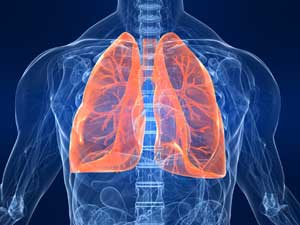Scientists at the University of Alabama at Birmingham (UAB) shed new light on mechanisms of acute lung injury in a paper published December 2012 online in the FASEB Journal. The study suggests, for the first time, one reason why two promising trials designed to investigate therapies for acute respiratory distress syndrome (ARDS) were halted for futility.
 ARDS is a reaction to various types of injury to the lung, involving inflammation that interferes with the exchange of oxygen and carbon dioxide. It is often fatal and usually requires mechanical ventilation and hospitalization in an intensive care unit. It is most frequently caused by sepsis, trauma or aspiration of gastric contents or as a result of pneumonia. There are about 150,000 cases of ARDS reported in the U.S. each year.
ARDS is a reaction to various types of injury to the lung, involving inflammation that interferes with the exchange of oxygen and carbon dioxide. It is often fatal and usually requires mechanical ventilation and hospitalization in an intensive care unit. It is most frequently caused by sepsis, trauma or aspiration of gastric contents or as a result of pneumonia. There are about 150,000 cases of ARDS reported in the U.S. each year.
One hallmark of acute lung injury and ARDS is an inability by the body to remove alveolar fluid (fluid that accumulates in alveoli cells in the lung) from the lung in a normal fashion. Studies indicate that fluid removal is impaired in more than 80 percent of patients with acute lung injury.
Previous research in animal models has suggested that ?2-adrenergic receptor (?2AR) agonists, a class of drugs frequently used to treat pulmonary diseases, would promote fluid removal from the airspaces of the lungs. Two large, multicenter phase III trials of ?2AR, organized by the National Institutes of Health and the British Medical Research Council, were launched to investigate this theory. Both were shut down when investigators determined that the drug was having no effect in removing alveolar fluid.
|
There are about 150,000 cases of acute respiratory distress syndrome reported in the U.S. each year. |
Researchers at UAB, along with colleagues at the University of California, San Francisco and Vanderbilt University, determined that a potential culprit was a protein known as interleukin 8 (IL-8). The research findings indicated that IL-8, which has been shown to be a critical mediator of acute lung injury in humans, inhibited the ability of ?2AR to promote alveolar fluid transport.
“This is an important discovery, as it helps to explain why ?2AR did not work as expected in the large clinical trials,” said Jean-Francois Pittet, M.D., professor in the UAB Department of Anesthesiology and lead investigator of the study. “This also suggests new avenues of study to find ways to overcome IL-8 inhibition of the ?2AR signaling in alveolar epithelial cells.”
Pittet says one of the major mechanisms of fluid removal after injury is the active transport of sodium and chloride ions across the alveolar cells. IL-8 seems to have a particular effect in inhibiting ?2AR-stimulated fluid transfer of these ions. Pittet says the next round of investigation might look at ways to boost the efficacy of ?2AR by inhibiting IL-8 signaling in the alveolar epithelium.
“We need to identify patients at risk for ARDS quickly, and begin treatment prior to the occurrence of the full lung injury,” said Pittet. “A better understanding of the underlying causes of ARDS and the barriers to effective treatment will help us design new therapeutic approaches.”